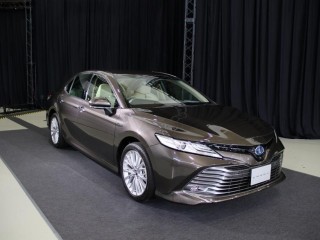Loading
Search
▼ Toyota Fully Remodels Camry Sedan
- Category:Driving
TOKYO - Toyota Motor Corp has fully remodeled its Camry mid-size sedan for the first time in six years.
Toyota said it developed a platform and a power train for the new Camry by using TNGA (Toyota New Global Architecture), which shares parts across segments. The new vehicle combines a 2.5-liter engine and the THS II hybrid system. Its fuel efficiency is 33.4km/liter (approx 78.6mpg).
The new Camry is manufactured at Toyota's Tsutsumi Plant. It aims to sell 2,400 units per month. Its price starts from ¥3,294,000 (including tax).
The most distinguishing feature of the new Camry is that it is equipped with a newly-developed engine having a thermal efficiency of 41%. It is a 2.5-liter in-line four-cylinder direct-injection gasoline engine and reported to be the successor to the existing 2AR engine.
Thus far, Toyota has already developed new models of the Prius and C-HR, by using the TNGA, but only the underbody has been shared by them. Starting from the new engine, the company will promote the sharing of power trains, planning to adopt design guidelines to be shared by nine kinds (17 variations) of engines by 2021.
For the Japanese market, Toyota released only a hybrid (HEV) model of the new Camry. The THS II was developed based on the hybrid system that is used for the fourth-generation Prius and designed for FF (front-engine, front-wheel-drive) vehicles.
Compared with the existing combination of a 2.5-liter engine and a hybrid system, the new system reduces the time it takes to increase speed from 40 to 70km/h (approx 24.9-43.5mph) by 10% and improves fuel efficiency by 20% under the JC08 test mode.
The maximum output and maximum torque of the engine are 131kW and 221N·m, respectively. The maximum output and maximum torque of the new Camry's motor are 88kW and 202N·m. It is equipped with a lithium-ion (Li-ion) battery. The vehicle measures 4,885 (L) x 1,840 (W) x 1,445mm (H), and its wheelbase is 2,825mm.
© Nikkei Technology
Toyota said it developed a platform and a power train for the new Camry by using TNGA (Toyota New Global Architecture), which shares parts across segments. The new vehicle combines a 2.5-liter engine and the THS II hybrid system. Its fuel efficiency is 33.4km/liter (approx 78.6mpg).
The new Camry is manufactured at Toyota's Tsutsumi Plant. It aims to sell 2,400 units per month. Its price starts from ¥3,294,000 (including tax).
The most distinguishing feature of the new Camry is that it is equipped with a newly-developed engine having a thermal efficiency of 41%. It is a 2.5-liter in-line four-cylinder direct-injection gasoline engine and reported to be the successor to the existing 2AR engine.
Thus far, Toyota has already developed new models of the Prius and C-HR, by using the TNGA, but only the underbody has been shared by them. Starting from the new engine, the company will promote the sharing of power trains, planning to adopt design guidelines to be shared by nine kinds (17 variations) of engines by 2021.
For the Japanese market, Toyota released only a hybrid (HEV) model of the new Camry. The THS II was developed based on the hybrid system that is used for the fourth-generation Prius and designed for FF (front-engine, front-wheel-drive) vehicles.
Compared with the existing combination of a 2.5-liter engine and a hybrid system, the new system reduces the time it takes to increase speed from 40 to 70km/h (approx 24.9-43.5mph) by 10% and improves fuel efficiency by 20% under the JC08 test mode.
The maximum output and maximum torque of the engine are 131kW and 221N·m, respectively. The maximum output and maximum torque of the new Camry's motor are 88kW and 202N·m. It is equipped with a lithium-ion (Li-ion) battery. The vehicle measures 4,885 (L) x 1,840 (W) x 1,445mm (H), and its wheelbase is 2,825mm.
© Nikkei Technology
- August 7, 2017
- Comment (0)
- Trackback(0)


